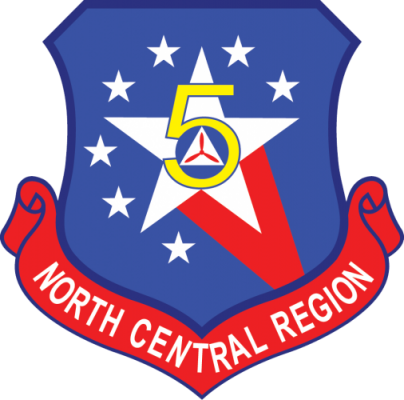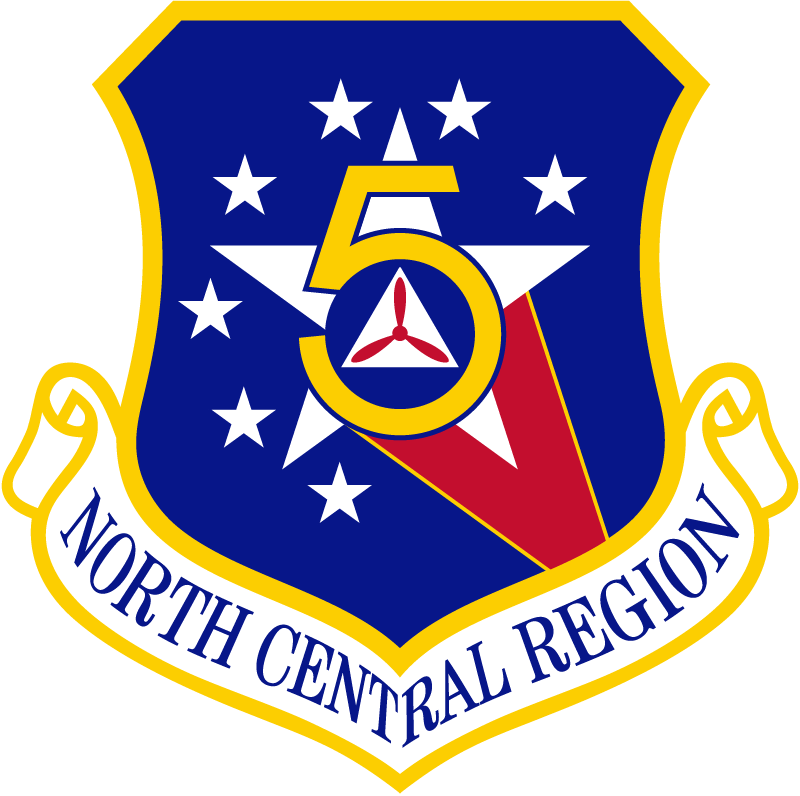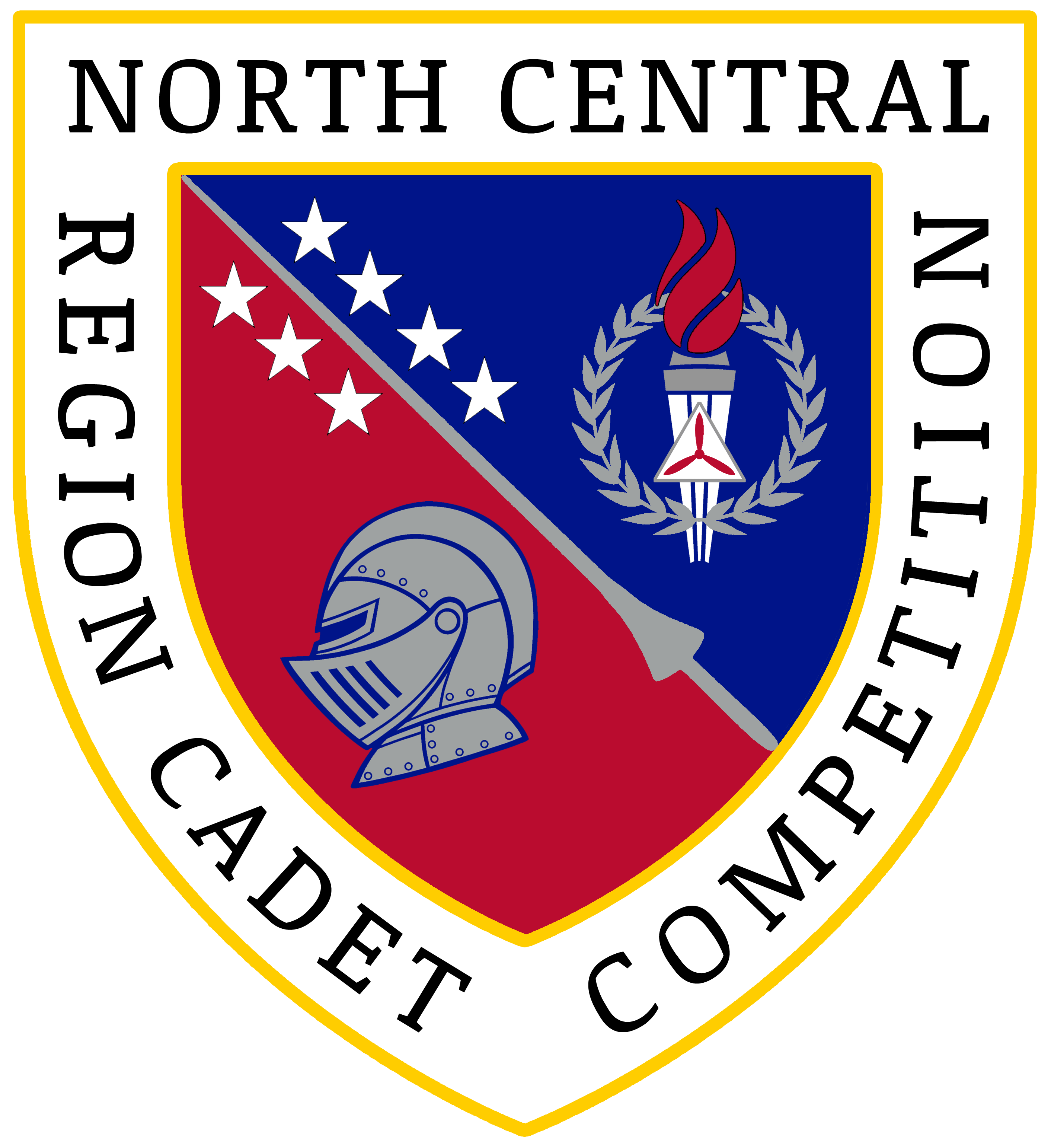

 The emblem of the North Central Region was designed by Major Ace Browning of Minnesota Wing in March 2011. It is a modernized conception of NCR's predecessor disk emblem, about which no historical information was available.
The emblem of the North Central Region was designed by Major Ace Browning of Minnesota Wing in March 2011. It is a modernized conception of NCR's predecessor disk emblem, about which no historical information was available.
The first concept kept the star clusters similar to the predecessor disk emblem. The second concept [at right] was chosen because it was more aesthetically appealing.
The colors have no intended meaning other than to mimic the predecessor disk emblem. The large star represents Region Headquarters, while the 7 smaller stars represent each Wing in the region. "5" is the region's designation from General Orders No. 9, dated April 24, 1952.
Changed from the predecessor disk emblem, the large star is now shooting upward, and its path forms a red "V" symbolizing a vanguard chevron as a historical reminder of our commitment to duty - an element borrowed from the Great Lakes Region emblem which Major Browning helped design in 1999.
Information provided by:
Maj Ace Browning, Minnesota Wing

 This is the original manufacturer's stich-out proof of the third North Central Region patch, not including the series of shoulder arcs. It was received by Colonel Thomas Theis, NCR/CC in July 2025 from Civil Air Patrol's official insignia manufacturer Vanguard Industries Inc in Norfolk, VA.
This is the original manufacturer's stich-out proof of the third North Central Region patch, not including the series of shoulder arcs. It was received by Colonel Thomas Theis, NCR/CC in July 2025 from Civil Air Patrol's official insignia manufacturer Vanguard Industries Inc in Norfolk, VA.
Since the proof was approved without change, it has little distinction from the first production run of patches available to CAP membership. There is a unique manufacturer's sticker heat-sealed into the back [PHOTO] which does not appear on the production patches.
NCR's predecessor emblem was updated by Major Ace Browning of Minnesota Wing to conform to Civil Air Patrol's Heraldry Program standards established in January 2021 as CAP Regulation 110-3. The new emblem was authorized by National Headquarters in January 2025.
Then at the sugestion of Colonel Seth Hudson, CAP National Historian, the scroll's font was changed after-the-fact from a Sans-Serif font to a Serif font which is the United States Air Force standard for emblems of this style. Lieutenant Colonel Matt Johnson, Utah Wing, created the proper style and shape of the scroll's text in February 2025.
Information provided by:
Maj Ace Browning, Minnesota Wing
July 23, 2025

ELEMENT ONE Stars - Represents the highly skilled teams from seven wings that compete.
Stars - Represents the highly skilled teams from seven wings that compete.
Lance - Represents the competition, a tournament determining the best of the best.
ELEMENT TWO
Torch - A symbol from the Renaissance representing knowledge and wisdom which the competition tests of its participants. The flame serves as a guiding light to cadets on the competition’s path and reminds them to lead by example by lighting a path for others to follow.
Laurel Wreath - A symbol from Ancient Rome indicating triumph, and each cadet’s earnest quest for victory at the competition.
CAP Charge - The "tri-blade" is a historic symbol of the Civil Air Patrol and is easily identifiable by all.
ELEMENT THREE
Great Helm - A symbol from the Middle Ages indicating the qualities of chivalry, including valor and honor. Knights considered their helmets an extension of their identity. Only the victorious team from each Cadet Competition may call themselves Knights, and year after year will be added to a cadre of the top cadets in North Central Region.
SHAPE & FIELD
The logo’s shape is a heater shield akin to that used by Knights in the 13th and 14th centuries, and the inspiration for the modified heater shield used by the United States Air Force.
The field is divided party per bind, with an Azure (blue) field sinister chief (upper-right) representing intelligence and truth, and a Gules (red) field dexter base (lower-left) representing determination and desire. The elements throughout are Argent (white/silver), the color of perfection. The shield’s border of Or (yellow/gold) symbolizes high quality. These are the colors of the North Central Region emblem.
Information provided by:
Maj Ace Browning, Minnesota Wing
February 12, 2024

Heraldry
 "The blue beret perched atop of the eight ball represents the Blue Berets. The number '8' represents the seven wings and region headquarters within the North Central Region. The eight ball represents the fact that Blue Berets are always 'behind the eight ball' when called out on missions."
"The blue beret perched atop of the eight ball represents the Blue Berets. The number '8' represents the seven wings and region headquarters within the North Central Region. The eight ball represents the fact that Blue Berets are always 'behind the eight ball' when called out on missions."
The real story is...
Around 1969, Mike Vorachek of Idaho Wing and Chaplain Raymond Aydt created the 8-ball design. It was based upon the plastic, liquid-filled 'Magic 8-ball' toy from Mattel - shake it up and it gives you an answer. It was inferred that the only decisions being made at one particular activity were made by the 8-ball and not the cadet staff. Putting the beret on top of it was only natural. Chaplain Aydt and Mike Vorachek went downtown in Williston, ND and had a drawing made. Later, they presented it to [then] Col William Cass, founder and commander of the Iowa Wing Blue Berets. He got a great kick out of it and the idea rapidly caught on. At the first Blue Beret reunion in 1969 held at Ledges State Park in Iowa, Chaplain Aydt presented the 8-ball design. When the activity's name changed from Iowa Wing Blue Berets to North Central Region Special Service Corps, the letters 'NCRSSC' were added to the 8-ball's beret, and the first pocket patches were made.
The 8-ball patch fell into disuse as the years went by, but in 1987 Captain Ken Gleich of Missouri Wing learned about the design. It was resurrected briefly during the last few years of Blue Beret when the activity became 'CAP-EAA Oshkosh' ran by Great Lakes Region. Very shortly after Blue Beret returned as a national activity in 1995, a new shoulder patch featuring the Saint Alban's Cross came into use.
Information provided by:
Christopher Yaroch